Published 3rd Apr. 2024
Reading time
One of the most distinctive birds in the animal kingdom, the flushing flamingo is an intriguing creature. Ranging in colour from pale rose to vibrant coral, flamingos are waterbirds at heart, found in colonies across the globe. Fancy feathers aside, from their special adaptations and marvellous mating rituals to their iconic postures, there’s much more to learn about these elegant birds. Read on for a lesson on the famous pink bird with our top ten flamingo facts…
1. Pink Plumage
2. Brilliant Bills
3. Co-parenting
4. One-legged Posture
5. Six Species
6. Flashy Birds
7. Habitats
8. Frequent Fliers
9. Choreographed Courtship
10. Longevity
1.
First up on our fascinating list of flamingo facts is an explanation of their distinctive hue. Did you know that their diet causes their pink plumage? Flamingo feathers transform thanks to foods rich in beta-carotene, like shrimps, snails, insect larvae, plankton and algae. Newborn chicks have downy grey and white feathers, which don’t develop a pink tinge until a couple of years later. Colour pigment varies by species, too, depending on the abundance of carotenoid-rich food available (Caribbean flamingo feathers are regarded as the brightest).
2.
In order to ingest their beta-carotene-rich meals, flamingos have specially adapted bills. Dunking their heads in the water, flamingos rely on these bills (when turned upside down) to sieve organisms out of the water. Called ‘filter-feeding’, flamingo bills feature tiny sieve-like openings on top, through which their tongues pump water. Separating mud and sand from their water-borne food, flamingos satisfy their omnivorous cravings and stay pretty in pink.
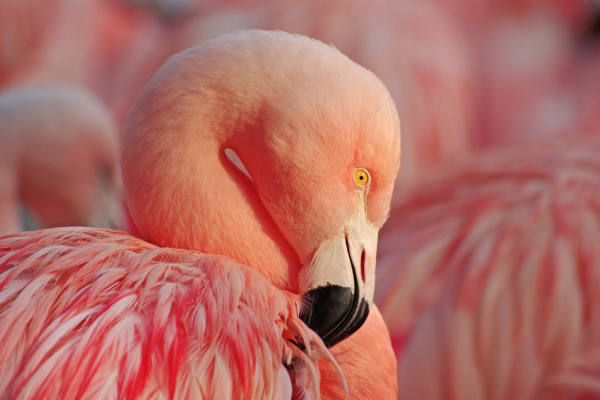
3.
Parenting in the flamingo kingdom is (rightly so) a shared responsibility. Remaining monogamous for the duration of the mating season, nest-building is a joint effort. Parents build mound-like mud nests along waterways for females to lay a single egg in. During the incubation period (around 30 days) both the male and female take it in turn to keep the egg warm and protected from harm. Both parents also feed their young with ‘crop milk’, a nutritious protein and fat-filled fluid from their digestive system. Sounds enticing…
4.
The birds’ mysterious penchant for standing one-legged is up next in our list of flamingo facts. While many theories attempt to explain this preferred posture, scientists believe its main purpose is to conserve body heat. One-legged postures are most often observed when flamingos are in the water (where they spend much of their time), where it’s crucial to keep body temperatures regulated. Flamingos are known to alternate their standing leg and can even sleep on just one.
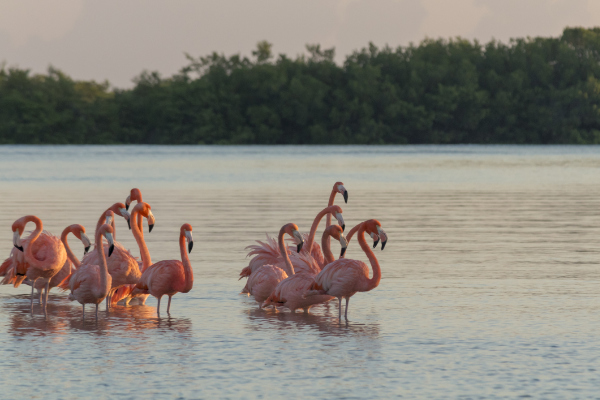
5.
Within the flamingo family, there are six different species: the Greater, the Lesser, the Chilean, the Andean, James’s and the American (or Caribbean). The largest of the lot is the Greater Flamingo (a name we’re sure the others wouldn’t be happy with), found in some parts of Africa, southern Europe and southwest Asia. The Lesser Flamingo is the smallest and most abundant species, mostly found in sub-Saharan Africa and western India.
6.
Facts about flamingos needn’t be dull. Case in point: a group of flamingos is called a flamboyance. Flamboyant in name and nature, flamingos are very social creatures, living their lives in colonies ranging in size between 50 and several thousand. Together, they hunt for food, look after young and stay alert for predators. Fittingly, a group of flamingo chicks is also called a creche. Sweet.
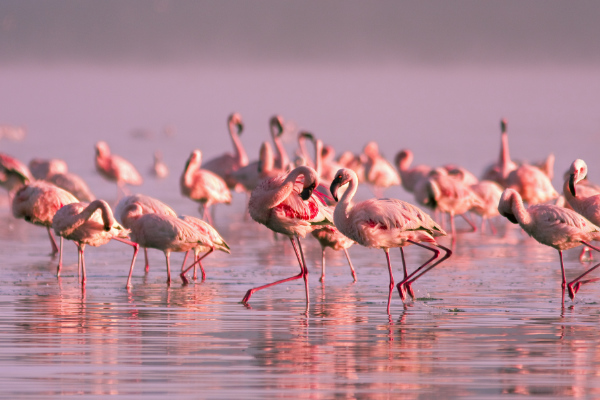
7.
Our favourite pink birds love tropical and subtropical environments and are native to parts of South America, Africa, Asia, and Europe. Flamingos favour shallow, wet habitats, ranging from fresh to saltwater lagoons, coastal areas, lakes and pans. Due to the demands of their diet, they can only live in specific habitats with high-salinity, mineral-rich waters where their food thrives. Thanks to flamingos’ vibrant feathers, you’ll have a good chance of spotting a group in the wild.
8.
Did you know that the fascinating flamingo is an excellent flier? With their long, slender necks, wide wingspans and willowy legs, flamingos are streamlined in flight, reaching speeds of up to 37mph. A flock of flamingos in flight often adopt an energy-conserving V-shaped formation, whether they’re migrating to a different area or searching for food. The envy of airline pilots, flamingos also have excellent take-off and landing skills. Using their webbed feet to pick up speed and run on the water, they also come in handy as landing breaks on touchdown.
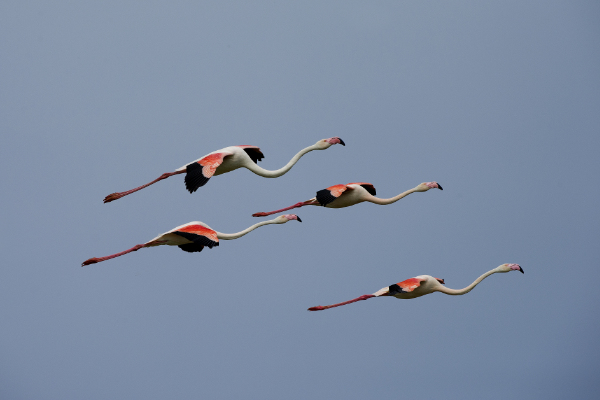
9.
A dancing flamboyance of flamingos is a spectacle that needs to be seen to be believed. Moving as a group, flamingos have elaborate mating rituals, which include synchronised head movements, pretend preening and wing salutes. Akin to a line dance, the flashy flamingos march together from left to right in a choreographed sequence, all in the hopes of attracting a mate for the breeding season. This has got to be one of our favourite flamingo facts.
10.
In the wild, these theatrical birds have few natural predators, living up to around 30 years (even longer in captivity). This is partly thanks to the nature of their habitats, which offer little food for other animals. If they venture too close to the shores, however, they’ll be the target of large mammals like lions, leopards, jaguars and cheetahs, while predatory birds, crocodiles and snakes are also known to attack flamingos. Expanding human settlements and polluted waters are likewise leading to increasing habitat loss.
Written by Hannah Whitehall
Practical advice and inspiration for your next trip
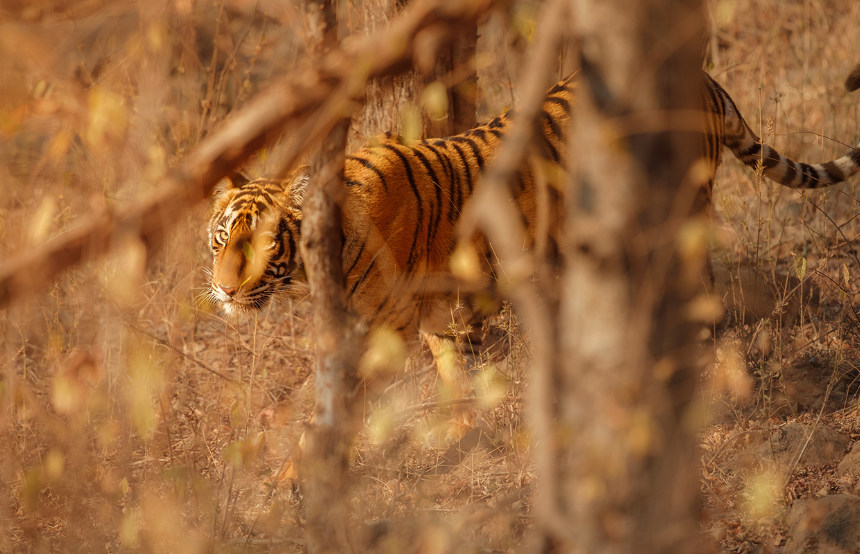
Searching for the best safaris in India? We’ve got you covered. Whether you’re keen to track tigers in Madhya Pradesh, admire Asiatic lions in Gujarat or photograph forest eagle owls in Kerala, your India holiday awaits. While Bengal tigers steal the limelight in Bandhavgarh National Park, don’t forget about the shaggy sloth bears (though they’re not as cuddly as they look). Feeling up for the adventure?
15th September 2025 - India Safari & Wildlife
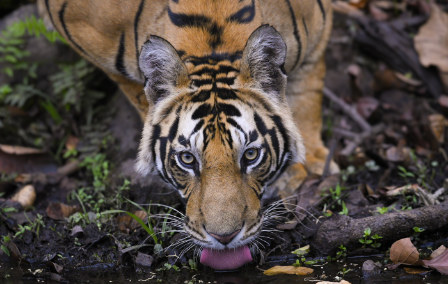
With their sleek, tangerine-tinged coats, piercing eyes and commanding presence, nothing beats the thrill of seeing a tiger in the wild. And where better than in India, home to the largest population on Earth? But when it comes to the best time to see tigers in India, it all depends on what you want from your trip. Whether you’d rather vivid green landscapes or crowd-free safaris, we’ve got the insider intel on when to see India’s famous big cats.
23rd June 2025 - India Safari & Wildlife
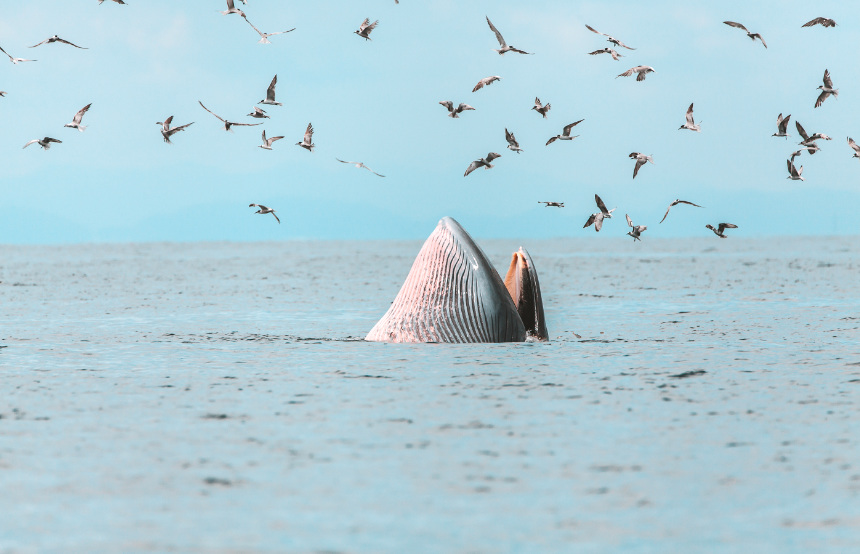
Where are the best places for whale watching? We’re glad you asked. From the picturesque Icelandic town of Husavik to the coastal haven of Mirissa in Sri Lanka, there are plenty of destinations to marvel at these majestic creatures. Picture this: the air is still and all you can hear is the creaking of the catamaran and the odd, excited whisper. You scan the horizon, desperate to spot the tip of a fluke or a distant plume of whale breath.
16th June 2025 - Safari & Wildlife

Our team of destination experts will get to know you and your unique requirements for your holiday

We work with you to build an ultra-personalised holiday itinerary with your choice of accommodation, experiences and activities

All of our holidays include little extras designed to make a big difference to your trip, from fast-tracking you through airport check-in and security to our network of local Concierges